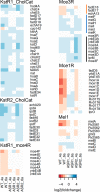Mce3R Stress-Resistance Pathway Is Vulnerable to Small-Molecule Targeting That Improves Tuberculosis Drug Activities
- PMID: 31012313
- PMCID: PMC6630528
- DOI: 10.1021/acsinfecdis.9b00099
Mce3R Stress-Resistance Pathway Is Vulnerable to Small-Molecule Targeting That Improves Tuberculosis Drug Activities
Abstract
One-third of the world's population carries Mycobacterium tuberculosis (Mtb), the infectious agent that causes tuberculosis (TB), and every 17 s someone dies of TB. After infection, Mtb can live dormant for decades in a granuloma structure arising from the host immune response, and cholesterol is important for this persistence of Mtb. Current treatments require long-duration drug regimens with many associated toxicities, which are compounded by the high doses required. We phenotypically screened 35 6-azasteroid analogues against Mtb and found that, at low micromolar concentrations, a subset of the analogues sensitized Mtb to multiple TB drugs. Two analogues were selected for further study to characterize the bactericidal activity of bedaquiline and isoniazid under normoxic and low-oxygen conditions. These two 6-azasteroids showed strong synergy with bedaquiline (fractional inhibitory concentration index = 0.21, bedaquiline minimal inhibitory concentration = 16 nM at 1 μM 6-azasteroid). The rate at which spontaneous resistance to one of the 6-azasteroids arose in the presence of bedaquiline was approximately 10-9, and the 6-azasteroid-resistant mutants retained their isoniazid and bedaquiline sensitivity. Genes in the cholesterol-regulated Mce3R regulon were required for 6-azasteroid activity, whereas genes in the cholesterol catabolism pathway were not. Expression of a subset of Mce3R genes was down-regulated upon 6-azasteroid treatment. The Mce3R regulon is implicated in stress resistance and is absent in saprophytic mycobacteria. This regulon encodes a cholesterol-regulated stress-resistance pathway that we conclude is important for pathogenesis and contributes to drug tolerance, and this pathway is vulnerable to small-molecule targeting in live mycobacteria.
Keywords: cholesterol; codrug; low oxygen.
Conflict of interest statement
The authors declare the following competing financial interest(s): X.Y., T.Y., and N.S.S. are named inventors on patents and patent applications related to this Article.
Figures






References
-
- Nesbitt N. M.; Yang X.; Fontán P.; Kolesnikova I.; Smith I.; Sampson N. S.; Dubnau E. (2010) A thiolase of Mycobacterium tuberculosis is required for virulence and production of androstenedione and androstadienedione from cholesterol. Infect. Immun. 78 (1), 275–282. 10.1128/IAI.00893-09. - DOI - PMC - PubMed
-
- Ouellet H.; Guan S.; Johnston J. B.; Chow E. D.; Kells P. M.; Burlingame A. L.; Cox J. S.; Podust L. M.; de Montellano P. R. (2010) Mycobacterium tuberculosis CYP125A1, a steroid C27 monooxygenase that detoxifies intracellularly generated cholest-4-en-3-one. Mol. Microbiol. 77 (3), 730–42. 10.1111/j.1365-2958.2010.07243.x. - DOI - PMC - PubMed
-
- Peyron P.; Vaubourgeix J.; Poquet Y.; Levillain F.; Botanch C.; Bardou F.; Daffe M.; Emile J. F.; Marchou B.; Cardona P. J.; de Chastellier C.; Altare F. (2008) Foamy macrophages from tuberculous patients’ granulomas constitute a nutrient-rich reservoir for M. tuberculosis persistence. PLoS Pathog. 4 (11), e1000204.10.1371/journal.ppat.1000204. - DOI - PMC - PubMed
Publication types
MeSH terms
Substances
Grants and funding
LinkOut - more resources
Full Text Sources
Molecular Biology Databases

